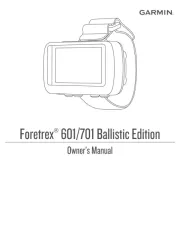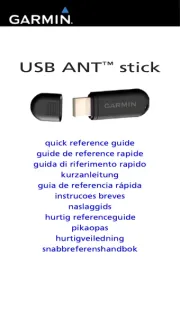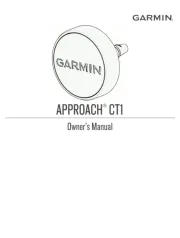Garmin GHP Compact Reactor 40 Handleiding
Garmin
Niet gecategoriseerd
GHP Compact Reactor 40
Bekijk gratis de handleiding van Garmin GHP Compact Reactor 40 (6 pagina’s), behorend tot de categorie Niet gecategoriseerd. Deze gids werd als nuttig beoordeeld door 243 mensen en kreeg gemiddeld 4.7 sterren uit 122 reviews. Heb je een vraag over Garmin GHP Compact Reactor 40 of wil je andere gebruikers van dit product iets vragen? Stel een vraag
Pagina 1/6

REACTOR™ 40 HYDRAULIC
Configuration Guide
Important Safety Information
WARNING
See the guide in the Important Safety and Product Information
product box for product warnings and other important
information.
You are responsible for the safe and prudent operation of your
vessel. The autopilot is a tool that enhances your capability to
operate your boat. It does not relieve you of the responsibility of
safely operating your boat. Avoid navigational hazards and
never leave the helm unattended.
Always be prepared to promptly regain manual control of your
boat.
Learn to operate the autopilot on calm and hazard-free open
water.
Use caution when operating the autopilot near hazards in the
water, such as docks, pilings, and other boats.
CAUTION
When in use, beware of hot motor and solenoid components
and the risk of entrapment from moving parts.
Failure to install and maintain this equipment in accordance with
these instructions could result in damage or injury.
NOTICE
To avoid damage to your boat, the autopilot system should be
installed by a qualified marine installer. Specific knowledge of
hydraulic steering componentry and marine electrical systems is
required for proper installation.
Configuring the Autopilot
The autopilot system must be configured and tuned to your boat
dynamics. The Dockside Wizard and the Sea Trial Wizard are
used to configure the autopilot. These wizards walk you through
the necessary configuration steps.
If your autopilot package did not contain a helm control, you
must configure the autopilot system using a compatible
chartplotter on the same NMEA 2000® network as the autopilot
CCU. Instructions for configuration using either the helm control
or a chartplotter are provided.
Dockside Wizard
NOTICE
If you perform the Dockside Wizard while your boat is out of the
water, provide rudder-movement clearance to avoid damage to
the rudder or other objects.
You can complete the Dockside Wizard while the boat is in or
out of the water.
If the boat is in the water, it must be stationary while you
complete the wizard.
Performing the Dockside Wizard
NOTICE
If you have a boat with a power assist steering system, turn on
the power assist steering system before performing the
Dockside Wizard to avoid damaging the steering system.
1Turn on the autopilot.
The first time you turn on the autopilot, you are prompted to
complete a short setup sequence.
2If the does not start automatically after the Dockside Wizard
setup sequence, select an option:
• On a helm control, select > > Menu Setup Dealer
Autopilot Setup Wizards Dockside Wizard > > .
• On a chartplotter, select > >Settings My Vessel
Autopilot Installation Setup Wizards Dockside > >
Wizard.
3Select the vessel type.
4If prompted, follow the on-screen instructions to set the helm
lock-to-lock,
5If prompted, follow the on-screen instructions to provide the
helm displacement value.
6If necessary, calibrate the rudder sensor (Calibrating the
Rudder Sensor, page 1).
7Test the steering direction (Testing the Steering Direction,
page 1).
8If necessary, select the speed source (Selecting a Speed
Source, page 2).
9If necessary, verify the tachometer (Verifying the
Tachometer, page 2).
10If prompted, test the helm lock-to-lock.
11Review the results of the (Dockside Wizard Reviewing the
Results of the Dockside Wizard, page 2).
Calibrating the Rudder Sensor
NOTE: If an error appears during these steps, the rudder
feedback sensor may have reached its limit. If this happens, the
rudder feedback sensor may not have been installed correctly. If
the problem persists, you can continue with calibration by
moving the rudder to the farthest position that does not report an
error.
1Position the rudder so that the boat would steer fully
starboard, and select .OK
2After the starboard calibration is complete, position the
rudder so that the boat would steer fully port, and select .OK
3After the port calibration is complete, center the rudder
position, let go, and select .Begin
The autopilot takes control of the rudder.
4Without touching the rudder, helm control, or chartplotter,
allow the autopilot to calibrate the rudder.
5Select an option:
• If the calibration did not complete successfully, repeat
steps 1 through 4.
• If the calibration completed successfully, select .OK
Testing the Steering Direction
1While sitting still or moving at a low rate of speed, select
and .
When you select , the rudder must turn the boat to the left.
When you select , the rudder must turn the boat to the right.
2Select .Continue
3Select an option:
• If the steering test turns the boat in the correct direction,
on a helm control, select .Yes
• If the steering test turns the boat in the correct direction,
on a chartplotter, select .Next
• If the steering test turns the boat in the opposite direction,
on a helm control, select , and repeat steps 1 though 3.No
• If the steering test turns the boat in the opposite direction,
on a chartplotter, select , and repeatSwitch Direction
steps 1 though 3.
November 2017
190-02314-00_0A

Selecting a Speed Source
Select an option:
• If you connected one or more NMEA 2000 compatible
engines to the NMEA 2000 network, select Tachometer -
NMEA 2000.
• If a NMEA 2000 tachometer data source is not available
from one or more engines, or if it is unusable, select GPS
as a speed source.
NOTE: Garmin® recommends using an external GPS
antenna mounted with a clear view of the sky to provide
reliable and accurate GPS speed information.
• If you did not connect a NMEA 2000 engine or GPS
device as a speed source, select .None
NOTE: None If the autopilot does not perform well using
as the speed source, Garmin recommends connecting a
tachometer through the NMEA 2000 network or using an
external GPS antenna as the speed source.
Verifying the Tachometer
This procedure does not appear when GPS or None is selected
as the speed source.
With the engine (or engines) running, compare the RPM
readings on the helm control with the tachometer (or
tachometers) on the dashboard of your boat.
If the RPM numbers do not align, there may be a problem
with the NMEA 2000 speed source or connection.
Reviewing the Results of the Dockside Wizard
The values you chose when you ran the Dockside Wizard are
displayed.
1Examine the results of the .Dockside Wizard
2Select any incorrect value.
3Correct the value.
4Repeat steps 2 and 3 for all incorrect values.
5When you are finished reviewing the values, select .Done
Sea Trial Wizard
The Sea Trial Wizard configures the fundamental sensors on the
autopilot, and it is extremely important to complete the wizard in
conditions appropriate for your boat.
Important Sea Trial Wizard Considerations
The Sea Trial Wizard must be completed in calm water.
Because the nature of calm water is relative to the size and
shape of the boat, before you begin the Sea Trial Wizard, the
boat must be in an appropriate location.
• The boat must not rock while sitting still or moving very
slowly.
• The boat must not be significantly affected by the wind.
While completing the Sea Trial Wizard, observe these
considerations.
• Weight on the boat must remain balanced. While completing
any of the steps in the Sea Trial Wizard, do not move around
on the boat.
Performing the Sea Trial Wizard
1Drive your boat to an open area of calm water.
2Select an option:
• On a helm control, select > > Menu Setup Dealer
Autopilot Setup Wizards Sea Trial Wizard > > .
• On a chartplotter, select > > Settings My Vessel
Autopilot Installation Setup Wizards Sea Trial > >
Wizard Begin > .
3Select an option:
• On a planing-hull power boat with the speed source set to
Tachometer - NMEA 2000, configure the planing RPM.
• On a planing-hull power boat with the speed source set to
GPS, configure the planing speed.
• On a power boat with the speed source set to
Tachometer - NMEA 2000 GPS or , configure the high
RPM limit.
• On a power boat with the speed source set to , GPS
configure the maximum speed.
4Calibrate the compass ( ).Calibrating the Compass, page 2
5Perform the procedure (Autotune Performing the Autotune
Procedure, page 2).
6Set north ( ), or set the fine heading Setting North, page 3
adjustment ( ).Setting the Fine Heading Adjustment, page 3
Calibrating the Compass
1Select an option:
• If you are performing this procedure as part of the Sea
Trial Wizard Begin, select .
• If you are performing this procedure outside of the Sea
Trial Wizard on a helm control, from the heading screen,
select > > > Menu Setup Dealer Autopilot Setup
Compass Setup Calibrate Compass Begin > > .
• If you are performing this procedure outside of the Sea
Trial Wizard Settings My on a chartplotter, select >
Vessel Autopilot Installation Setup Compass > >
Setup Compass Cal. Begin > > .
2Follow the directions until calibration is complete, taking care
to keep the boat as steady and flat as possible.
The boat should not list during calibration. Make sure one
side of the vessel is not loaded more heavily than the other.
3Select an option:
• If the calibration completes successfully on a helm control,
select .Done
• If the calibration completes successfully, on a chartplotter
select .OK
• If the calibration is not successful, select and repeat Retry
steps 1 through 3.
When the calibration is complete, a magnetic environment
quality value is shown. A value of 100 indicates the CCU was
installed in a perfect magnetic environment and calibrated
correctly. If this value is low, you might need to relocate the
CCU and calibrate the compass again.
Performing the Autotune Procedure
Before you can begin this procedure, you must have a large
stretch of open water available.
1Adjust the throttle so the boat travels at a typical cruising
speed (below planing speed) that provides responsive
steering.
2Select an option:
• If you are performing this procedure as part of the Sea
Trial Wizard Begin, select .
• If you are performing this procedure outside of the Sea
Trial Wizard on a helm control, from the heading screen,
select > > > Menu Setup Dealer Autopilot Setup
Autopilot Tuning Autotune Begin > > .
• If you are performing this procedure outside of the Sea
Trial Wizard Settings My on a chartplotter, select >
Vessel Autopilot Installation Setup Autopilot > >
Tuning Autotune Begin > > .
The boat performs various zigzag motions while the Autotune
is in progress.
3After the procedure is finished, follow the on-screen
instructions.
2

4If the procedure is not successful, select an option:Autotune
• If the procedure is not successful and you have Autotune
not reached maximum cruising speed, increase the speed,
select on a helm control or Run Normal Autotune Run
Standard Autotune on a chartplotter, and repeat steps 1
through 3 until the procedure completes Autotune
successfully.
• If the procedure is not successful and you have Autotune
reached maximum cruising speed, reduce your speed to
the initial speed, and select Autotune Run Alternate
Autotune to begin an alternate procedure.
• If the fails immediately and you are traveling in Autotune
a circle instead of performing zigzag motions, select
Reverse Steering Dir. Run Normal Autotune > on a
helm control or > Switch Direction Run Standard
Autotune on a chartplotter, and repeat steps 1 through 3
until the procedure completes successfully.Autotune
When the Autotune procedure is complete, gain values are
displayed. You can use these values to determine the quality of
the Autotune procedure.
Autotune Gain Values
After the Autotune procedure is complete, you can review the
gain values provided on the helm control. You can record these
numbers for reference if you want to run the autotune procedure
at a later time or if you want to manually adjust the gain settings
(not recommended) (Adjusting the Autopilot Gain Settings,
page 4).
Gain: Sets how tightly the autopilot holds the heading and how
aggressively it makes turns.
Counter Gain: Sets how aggressively the autopilot adjusts any
over-steering after making a turn.
Setting North
Before you can begin this procedure, you must have a large
stretch of open water available.
This procedure appears if the autopilot is connected to an
optional GPS device, and the device has acquired a GPS
position. During this procedure, the autopilot aligns the compass
heading with the Course over Ground (COG) information from
the GPS device.
If you do not have a GPS device connected, you are prompted
to set the fine heading adjustment instead (Setting the Fine
Heading Adjustment, page 3).
1Drive your boat at in a straight line at cruising speed,
downwind, and in the same direction as the current.
2Select an option:
• If you are performing this procedure as part of the Sea
Trial Wizard Begin, select .
• If you are performing this procedure outside of the Sea
Trial Wizard on a helm control, from the heading screen,
select > > > Menu Setup Dealer Autopilot Setup
Compass Setup Set North Begin > > .
• If you are performing this procedure outside of the Sea
Trial Wizard Settings My on a chartplotter, select >
Vessel Autopilot Installation Setup Compass > >
Setup Set North Begin > > .
3Continue to drive the boat in a straight line at cruising speed,
downwind, in the same direction as the current, and follow
the on-screen instructions.
4Select an option:
• If the calibration completes successfully, select .Done
• If the calibration is not successful, repeat steps 1 through
3.
Setting the Fine Heading Adjustment
This procedure appears only if you do not have an optional GPS
device connected to the autopilot. If the autopilot is connected to
a GPS device that has acquired a GPS position, you are
prompted to set north instead ( ).Setting North, page 3
1Select an option:
• If you are performing this procedure as part of the Sea
Trial Wizard, proceed to step 3.
• If you are performing this calibration outside of the Sea
Trial Wizard on a helm control, from the heading screen,
select > > > Menu Setup Dealer Autopilot Setup
Compass Setup Fine Heading Adjustment > .
• If you are performing this calibration outside of the Sea
Trial Wizard Settings My on a chartplotter, select >
Vessel Autopilot Installation Setup Compass > >
Setup Fine Heading Adjustment Begin > > .
2Adjust the fine heading setting until it shows the correct
heading as determined by a trusted heading indicator, such
as the ship compass or a handheld compass.
3Select .Back
Testing and Adjusting the Configuration
NOTICE
Test the autopilot at a slow speed. After the autopilot has been
tested and adjusted at a slow speed, test it at a higher speed to
simulate normal operating conditions.
1Drive the boat in one direction with the autopilot engaged
(heading hold).
The boat may oscillate slightly, but it should not oscillate
significantly.
2Turn the boat in one direction using the autopilot and observe
the behavior.
The boat should turn smoothly, not too quickly or too slowly.
When you turn the boat using the autopilot, the boat should
approach and settle on the desired heading with minimal
overshoot and oscillation.
3Select an option:
• If the boat turns too quickly or too sluggishly, adjust the
autopilot acceleration limiter (Adjusting the Acceleration
Limiter Settings, page 3).
• If the heading hold oscillates significantly or the boat does
not correct when turning, adjust the autopilot gain
( ).Adjusting the Autopilot Gain Settings, page 4
• If the boat turns smoothly, the heading hold oscillates only
slightly or not at all, the boat adjusts the heading correctly,
the configuration is correct. No further adjustments are
necessary.
Adjusting the Acceleration Limiter Settings
1On a helm control, enable Dealer Mode (Enabling Dealer
Configuration on the Helm Control, page 4).
2Select an option:
• On a helm control, from the heading screen, select Menu
> > > > Setup Dealer Autopilot Setup Autopilot Tuning
Acceleration Limiter.
• On a chartplotter, select > > Settings My Vessel
Autopilot Installation Setup Autopilot Tuning > >
Accel. Limiter.
3Select an option:
• Increase the setting if the autopilot turns too quickly.
• Decrease the setting if the autopilot turns too slowly.
When you manually adjust the acceleration limiter, make
relatively small adjustments. Test the change before making
additional adjustments.
3
Product specificaties
| Merk: | Garmin |
| Categorie: | Niet gecategoriseerd |
| Model: | GHP Compact Reactor 40 |
Heb je hulp nodig?
Als je hulp nodig hebt met Garmin GHP Compact Reactor 40 stel dan hieronder een vraag en andere gebruikers zullen je antwoorden
Handleiding Niet gecategoriseerd Garmin

11 Augustus 2025

7 Mei 2025

25 Februari 2025

9 Januari 2025

9 Januari 2025

14 December 2024

13 November 2024

2 Oktober 2024

23 Juli 2024

25 Juni 2024
Handleiding Niet gecategoriseerd
- Etna
- UNITEK
- Firefield
- Fezz
- Britax
- Walkstool
- Graphite
- Summit
- PUQpress
- Bicker Elektronik
- Cleco
- Lumantek
- Access Lighting
- Aida
- Brady
Nieuwste handleidingen voor Niet gecategoriseerd

14 September 2025

14 September 2025

13 September 2025

13 September 2025

13 September 2025

13 September 2025

13 September 2025

13 September 2025

13 September 2025

13 September 2025